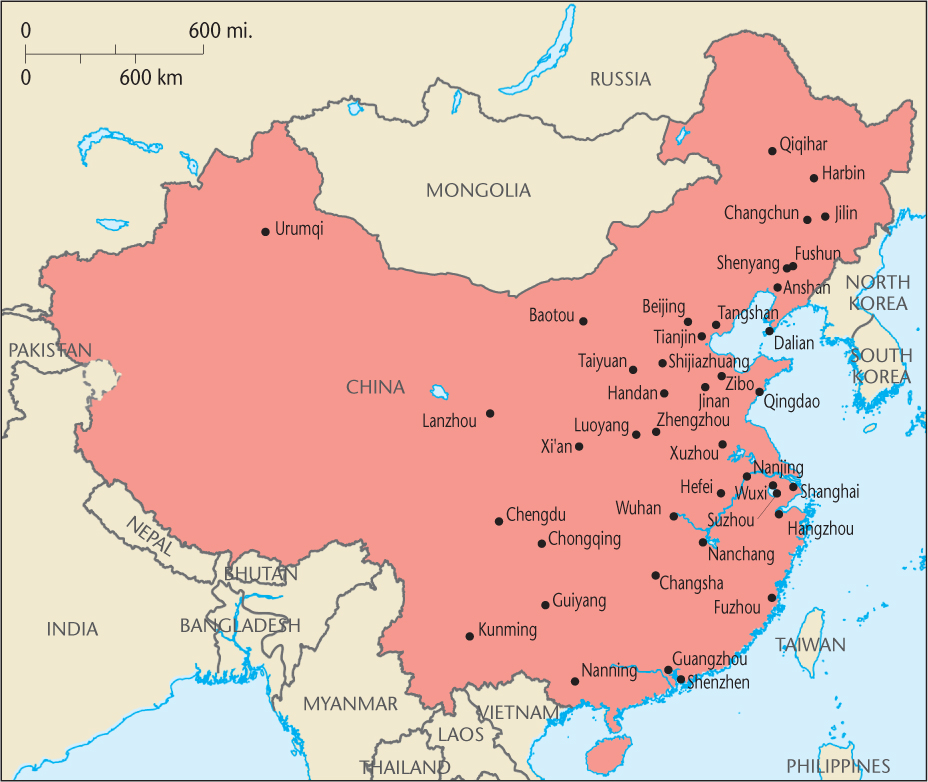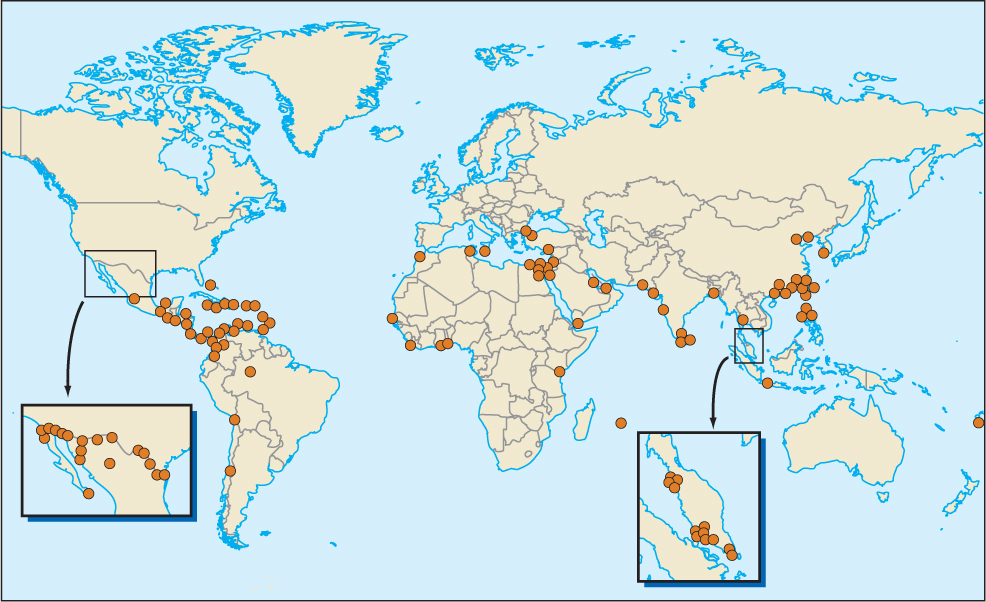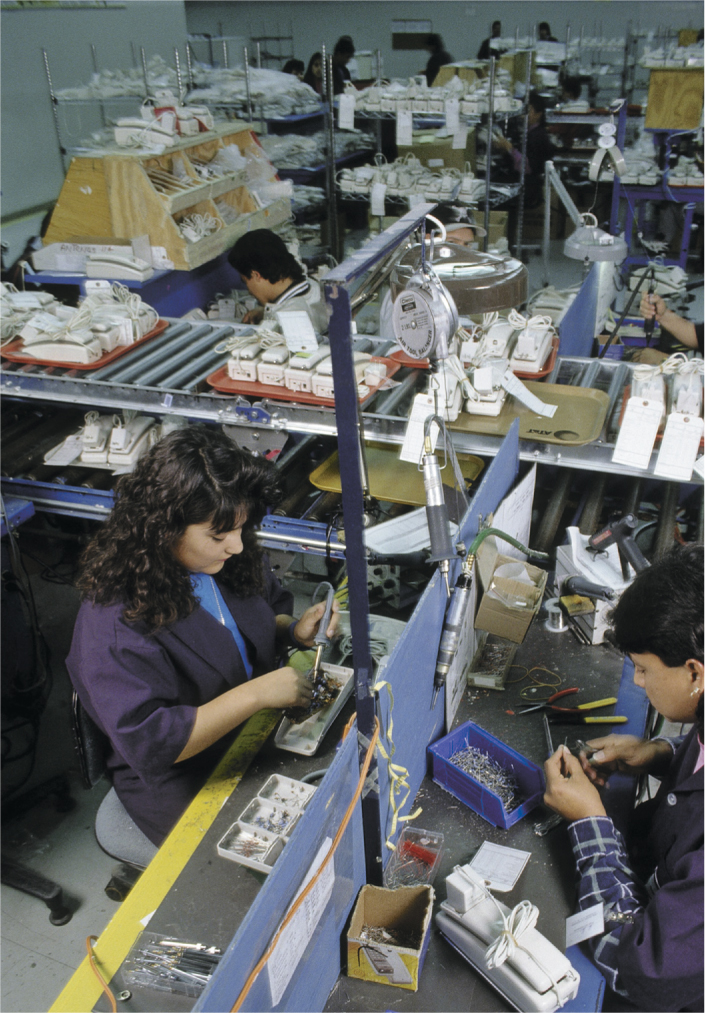Industrial-Economic Cultural Interaction
Industrial-Economic Cultural Interaction

Can our understanding of the industrialized world be aided by the theme of cultural interaction? Yes, but in a very different way from cultural ecology. Cultural interaction mainly allows us to understand the location of industries. The causal factors influencing industrial location include various economic features, especially labor supply.
Labor Supply
Labor Supply
labor-intensive industry An industry whose labor costs constitute a large portion of total production costs.
Labor-intensive industries are those industries in which labor costs form a large part of total production costs. Examples include industries that depend on skilled workers producing small objects of high value, such as computers, cameras, and watches, and industries that require large numbers of semiskilled workers, such as the textile and garment industries. Manufacturers consider several characteristics of labor in deciding where to locate factories: availability of workers, average wages, necessary skills, and worker productivity. Workers with certain skills tend to live and work in a small number of places, partly as a result of the need for higher education or for person-to-person training in handing down such skills. Consequently, manufacturers often seek locations where these skilled workers live. Geographer Amy Glasmeier has traced the history and contemporary conditions of the watchmaking industry in four countries (Great Britain, the United States, Switzerland, and Japan) and shown how the availability of a pool of skilled labor and the maintenance of that pool through different forms of education and training were critical to the success of these businesses.
In recent decades, with the increasing effects of globalization, two trends have been evident in terms of the relationship between the location of industry and labor supply. On the one hand, the increased mobility of people has in some ways lessened the locational influence of the labor force. Large numbers of workers around the globe have migrated to manufacturing regions. Today, labor migration is at an all-time high, lessening labor’s influence on industrial location. On the other hand, particularly for industries that are reliant on large pools of labor and that are transnational in structure, the location of labor has become even more important. These industries are often referred to as footloose, in the sense that they shift the location of their facilities in search of cheap labor. Thus we see how globalization is enabling more industries to locate their production facilities close to labor supply.
outsource The physical separation of some economic activities from the main production facility, usually for the purpose of employing cheaper labor.
Some companies are even locating their producer service activities in places where they can take advantage of cheaper labor costs. In the 1990s, many companies began to move what were typically called secretarial jobs—filing, typing, document formatting, and so on—out of their corporate headquarters and into places and spaces that were cheaper, both in terms of rental of office space and especially in terms of labor costs. More recently, some types of businesses, such as accounting firms, Wall Street investment houses, advertising agencies, and insurance companies, have found it cost-effective to outsource other white-collar jobs that are generally considered more skilled, such as legal research, financial analysis, and accounting. In general, outsourcing involves the physical separation of some economic activities from the main production facility. Chennai (formerly known as Madras), India, for example, is a primary site of these more skilled outsourced activities (Figure 9.16). Here, educated and highly skilled workers are trained to do these jobs; they are paid the equivalent of $10,000 to $20,000 a year, compared to the average annual salary of $100,000 for a similar worker in New York City.

Thinking Geographically
Question 9.18
Although there are still many call centers in the United States, why are these services increasingly being outsourced?
Markets
Markets
market The geographical area in which a product may be sold in a volume and at a price profitable to the manufacturer.
Geographically, a market includes the area in which a product may be sold in a volume and at a price profitable to the manufacturer. The size and distribution of markets are generally the most important factors in determining the spatial distribution of industries. With globalization, markets have expanded to cover most of the regions in the world, but even so the costs of shipping may prohibit particular kinds of manufactured goods from being sold worldwide. Some manufacturers have to situate their factories among their customers to minimize costs and maximize profits. Such industries include those that manufacture a weight-gaining finished product, such as bottled beverages, or a bulk-gaining finished product, such as metal containers or bottles. In other words, if weight or bulk is added to the raw materials in the manufacturing process, location near the market is economically desirable because of the high transportation costs. Similarly, if the finished product is more perishable or time-sensitive than the raw materials, as with baked goods and local newspapers, a location near the market also is required. In addition, if the product is more fragile than the raw materials that go into its manufacture, as with glass items, the industry will be attracted to locations near its market. In each of these cases—gain in weight or bulk, perishability, or fragility—transportation costs of the finished product are much higher than those of the raw materials. In contrast, items that become easier to transport after manufacturing often are produced in locations close to the site of the raw materials.
268
As a rule, we can say that the greatest market potential exists where the largest numbers of people live. This is why many manufacturing firms today are looking to the large population centers in such countries as India, China, and Russia for what they consider their emerging markets. The term emerging markets refers to places within the global economy that have recently been opened to foreign trade and where populations are just beginning to accumulate capital that they can spend on goods and services. In China, for example, globalization has led to a huge increase in industrialization, and these industries create jobs for people that allow them to purchase consumer goods. China’s large population base (over 1.3 billion people) serves as both a great source of labor and an expanding consumer market. Because China has more than 40 cities with populations exceeding a million (Figure 9.17) and also has a stable government that encourages foreign investment, transnational companies find the opportunities for low-cost production and expanding consumption there appealing.

Thinking Geographically
Question 9.19
Why do you think most of these cities are increasing in population?
The Political Element
The Political Element
So far, we’ve considered the roles of labor, corporations, and consumers in economic processes, but governments are major players, too. Governmental policies shape economic activities on scales that range from urban areas to regions to nations to the globe. Governments often intervene directly in decisions about industrial location. Such intervention typically results from a desire to encourage foreign investment; to create national self-sufficiency by diversifying industries; to bring industrial development and a higher standard of living to poverty-stricken provinces; to establish strategic, militarily important industries that otherwise would not develop; or to halt agglomeration in existing industrial areas. Such governmental influence becomes most pronounced in highly planned economic systems, particularly in certain socialist countries such as China, but it works to some extent in almost every industrial nation.
Other types of government influence come in the form of tariffs (taxes on imported goods), import-export quotas, political obstacles to the free movement of labor and capital, and various methods of hindering transportation across borders. Tariffs in effect reduce the size of a market area proportionally to the amount of tariff imposed. A similar effect is produced when the number of border-crossing points is restricted. In some parts of the world, especially Europe, the impact of tariffs and borders on industrial location has been greatly reduced by the establishment of free-trade blocs—groups of nations that have banded together economically and abolished most tariffs. Of these associations, the European Union (EU) is perhaps the most famous. Composed of 27 nations, the EU has succeeded in abolishing tariffs within its area. The North American Free Trade Agreement (NAFTA) among the United States, Canada, and Mexico is a similar arrangement in the Western Hemisphere. At a much larger spatial scale, the World Trade Organization (WTO) administers trade agreements and settles trade disputes, including those over tariffs, throughout much of the world. With nearly 150 member countries, the WTO regulates approximately 97 percent of world trade.
Governments can also exert political influence on economic activity in other ways that distort aspects of their national economies. For example, many governments establish guaranteed minimum prices for certain domestic commodities and import duties (taxes) on competing products from other countries. This practice is often found in the agricultural sector, as governments set prices for farm commodities at levels higher than the world market would support. The chief goal is to ensure an acceptable standard of living for farmers and to preserve rural heritage. A large-scale example of agricultural price supports is the EU’s Common Agricultural Policy (CAP). This program of farm subsidies, price supports, import tariffs, and quotas has cost the EU up to half its annual budget in some years, often exceeding 50 billion per year. Many European residents have protested these expenditures, leading to plans to greatly reduce EU spending on the program by 2013. After that time, farm subsidies and agricultural price supports will likely be used only in emergencies such as natural disasters or outbreaks of plant and animal diseases. These EU budgetary changes are projected to reduce certain distortions of world agricultural markets.
269
National governments can also influence economic markets through the protection of emerging industries or infant industries. Those who support the protection of infant industries argue that new domestic industries often do not have sufficient economies of scale (size) to compete with similar industries in other countries. Governments can attempt to protect these developing industries by insulating them from foreign competition and by protecting export activity through the lowering or elimination of tariffs. Some governments have even nationalized banks in order to make financing readily available to infant industries needing to borrow investment capital. A well-known case of this type of protectionism occurred in South Korea after the Korean War, when the government acted to shelter many domestic industries (including auto manufacturing, petroleum refining, shipbuilding, and electronics) in order to become competitive on the world stage. These measures led to great successes in many industries, allowing South Korea to take its place among the world leaders in manufacturing today. However, there have been cases in which government protection of infant industries has failed to achieve similar results. For example, in the 1980s, the Brazilian government chose to protect its infant computer industry against outside competitors, but the industry failed to develop and the technological gap between Brazil and the rest of the world at that time actually widened as a result.
export processing zone (EPZ) Designated area of a country where the government provides conditions conducive to export-oriented production. Called special economic zone (SEZ) in China.
maquiladora U.S.-owned assembly plant located on the Mexican side of the U.S.–Mexican border.
Considering the extent of government manipulation of economic markets in agriculture and industry, it would seem that transnational corporations, which scatter their holdings across international borders, would suffer. In reality, however, multinational enterprises are well placed to take advantage of some government policies. Various countries act differently to encourage or discourage foreign investment, creating major spatial discontinuities in opportunities for global corporations. Areas where foreign investment is encouraged are often called export processing zones (EPZs), although in China they are called special economic zones (SEZs). In general, these zones are designated areas of countries where governments create conditions conducive to export-oriented production, including trade concessions, exemptions from certain types of legislation, provision of physical infrastructure and services, and waivers of restrictions on foreign ownership. According to Peter Dicken, about 90 percent of these zones are located in Latin America, the Caribbean, and Asia (Figure 9.18). Those located along the U.S.–Mexican border are populated by U.S.-owned assembly plants called maquiladoras (Figure 9.19), most of which utilize Mexican low-wage labor, predominantly women, to produce textiles, clothing, and electronics for the export market.

Thinking Geographically
Question 9.20
What explains this phenomenon?

Thinking Geographically
Question 9.21
Why are many of these workers women?
270
Industrialization, Globalization, and Cultural Change
Industrialization, Globalization, and Cultural Change
Industrialization and globalization bring with them enormous changes, and those changes have profound impacts on peoples’ lives. As we have already seen in this chapter, the globalization of industry can radically alter regional economies, while the increase in international trade that is a major consequence of globalization allows for the circulation of new and different types of consumer goods and services throughout much of the world. Some very fundamental changes in how people live their everyday lives often accompany these large economic transformations. Increased interregional trade often leads to intercultural contact and the introduction of different ways of living and working to formerly isolated regions. The locational shifts of industries into new regions of the world can precipitate large movements of people from rural, farming areas into cities to work in factories. In some places in the world, economic development has restructured families and reshaped gender roles. For example, many transnational companies seek out a female labor force to work in their factories, since they believe women are more reliable and pliant workers, and also because in general they can pay them less than they pay men.
271
Even though globalization has spread industries and services throughout the world, not all groups of people have benefited equally. Some regions of the world have remained relatively underdeveloped, serving the global economy as sources of raw materials and low-wage labor, while other areas of the world benefit from the cheaper costs of production elsewhere to raise their standards of living. This can be explained by a large range of factors: the particular histories and physical geographies of certain countries, their situation within the geopolitical world (see chapter 6), international trade agreements, and the types of people who live in different regions and their cultures.